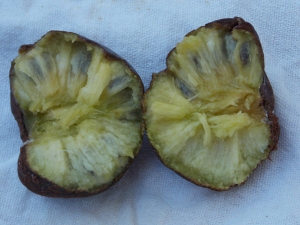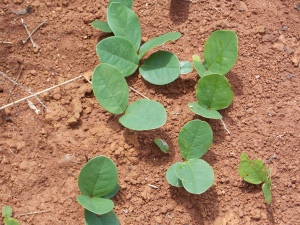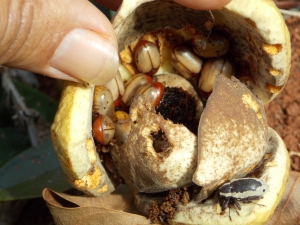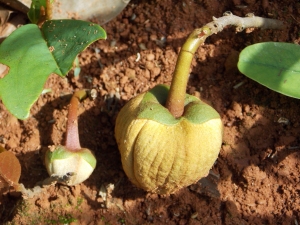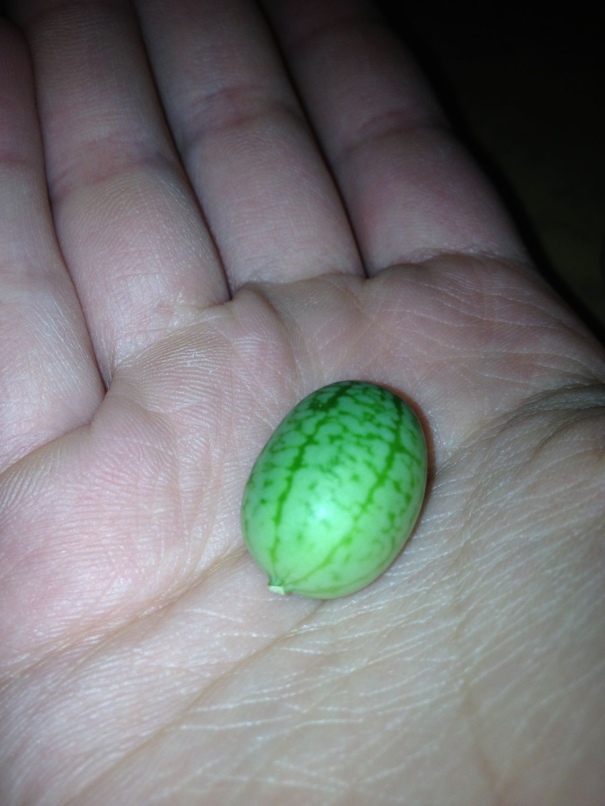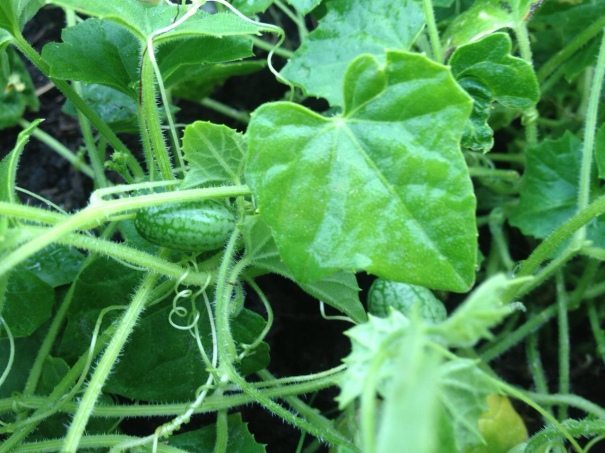This post is dedicated to the crown jewel of the world of plants, the genus annona. For those of you who are not familiar with these, annonas are the type genus of the family annonaceae, which also contains plants such as pawpaw (asimina triloba) and ylang-ylang (cananga odorata).

Pawpaw (asimina triloba)
This plants leaves contain a chemical that cause them to, when crushed, give off a scent akin to bell peppers.
Plants in the genus do not produce a true fruit, as with most magnoliales (the order that contains magnolias, along with the annonas), but instead aggregate fruit, a fruit from a single flower composed of many ovaries, which fuse together to create a single structure from several fleshy carpels (druplets), in the same manner as raspberry. The several commonly known annonas include sugar apples (annona squamosa), guanabana (annona muricata), and perhaps the most highly esteemed, cherimoya (annona cherimola), which are sometimes classified as dessert fruit for their creamy texture and custard like flavor. In this post, however, our focus will be on the much lesser known annonas.
•••
Annona Conica Ruiz & amp; Pav. ex G.Don
Synonyms:
•Raimondia conica (Ruiz & Pav. ex G. Don) Westra
•Raimondia quinduensis var. latifolia R. E. Fr.
•Raimondia stenocarpa R. E. Fr.
About:
This tree became endangered in 2003 due to habitat loss, it’s habitat being the wet microclimate of creeks found in the dry forests of northern South America. Unfortunately, there are no conservative actions towards this species.
Native Range: Northwest Equador
Fruit:
A small, elongated yellow fruit with sweetish white flesh. The fruit shape is variable, though usually cone shaped, with small, evenly spaced protuberances. They are often born in clusters of three to four, increasing the oddity of this tree.
Length: 10 to 12 Centimeters (4 to 5 inches)
Width: 3 Centimeters (1 inch)
Bearing Age: 2 Years
•••
Annona Cornifolia A. St.Hill.
Synonyms:
•Annona walkeri S. Moore
Common Names:
•Caritu-Cuí
•Red Arachitchu
About:
A very small bush native to the Cerrado with the amazing characteristic that the flowers can heat up nearly 8 degrees Celsius (14.5 degrees Fahrenheit) warmer than the surrounding climate, in order to push out an insect-attracting aroma, which is a scent that has been compared to an ink marker.
Native Range: Central Brazil
Plant Size: 1 to 2 Meters (3 to 6.5 feet)
Fruit:
A striking, mammilate fruit with thin, blood red to deep orange skin surrounding mildly sweet, orange pulp and several brown seeds. The fruit’s carpels are easily seperated, similar to those of the well known sugar apple (Annona squamosa). Seeds are can be difficult to germinate, often taking 3 to 18 months.
Length: 2.5 to 4 Centimeters (1 to 2.5 inches)
Width: 2.5 to 5 Centimeters (1 to 2 inches)
Bearing Age: 4 to 5 Years
•••
Annona Purpurea Moç. & Sessé ex Dunal
•Synonyms:
•Annona involucrata Baill.
•Annona manirote Kunth
•Annona prestoei Hemsl.
Common Names:
•Cabeza de Negro
•Manirote
•Soncoya
•Turagua
About:
The leaves are very large, up to 24 centimeters (9.5 inches) long and 12 centimeters (4.75 inches) wide, having a soft brown underside and a taper to a point. The seeds are dispersed by primates in their native range, but without them the plants can be rather weedy.
Native Range: Central America
Plant Size: 4 to 12 Meters (13 to 39 feet)
Fruit:
Large, spherical fruit with hard, green to brown spiny skin and orange, fiberous flesh of mediocre quality, highly aromatic with a scent most commonly compared to that of a mango. The pulp, when strained, has many medicinal qualities, and is used to cure fevers, chills, and jaundice (thought to be because of the pulp color), although certain cultures consider the fruit unwholesome.
Length: 15 to 20 Centimeters (6 to 8 inches)
Width: As Above
Bearing Age: 3 Years
Fruiting Season: August to October
•••
Annona Senegalensis Pers.
Synonyms:
•Annona arenaria Thonn. ex Schum.
•Annona chrysophylla Boj.
•Annona porpetac Boiv. ex Baill.
Subspecies:
Annona senegalensis subsp. oulotricha Le Thomas
Common Names:
•African Custard Apple
•Muvulu
•Wild Custard Apple
•Wild Soursop
About:
A small tree with large, soft, rounded leaves and furrowed bark. Seeds can be very difficult to germinate, treatment is advised for best germination. In it’s natural range it is pollinated by beetles, and when grown outside elsewhere hand pollination is ususually necessary. Excluding the seeds, all parts of the plant are eaten, the leaves by many animals besides humans including giraffe and elephants, and the roots are used by women to wean their infants.
Native Range: Central and Southern Africa
Plant Size: 2 to 6 Meters (6.5 to 20 feet)
Fruit:
Excellent, though very seedy fruit. The dry and oily orange flesh is aromatic with a scent akin to pineapple, tasting somewhat like a carrot. The seeds gerimate sporadically over the course of about two years.
Lenghth: 2 to 5 Centimeters (0.5 to 2 inches)
Width: 2 to 4 Centimeters (0.5 to 1.5 inches)
Fruiting Season: January to March
•••
Annona Stenophylla Engl. & Diels
Synonyms:
•Annona cuneata (Oliv.) R.E.Fr.
•Annona cuneata var. longepetiolata R.E.Fr.
•Annona friesii Robyns & Ghesq.
•Annona friesii var. elongata
•Annona longipetiolata (R.E.Fr.) Robyns & Ghesq.
•Annona longipetiolata var. precaria Robyns & Ghesq.
•Annona nana Exell
•Annona nana var. katangensis Robyns & Ghesq.
•Annona nana var. oblonga Robyns & Ghesq.
•Annona nana var. sessilifolia Excell
•Annona senegalensis var. cuneata Oliv.
•Annona senegalensis var. glabrescens Oliv
•Annona senegalensis var. rhodesiaca Engl. & Diels
•Annona senegalensis var. subsessilifolia Engl.
•Annona stenophylla var. nana R.E.Fr.
Subspecies:
•Annona stenophylla subsp. cuneata (Oliv.) N.Robso
•Annona stenophylla subsp. longipetiolata (R.E.Fr.) N.Robson
•Annona stenophylla subsp. nana (Exell) N.Robson
Common Name:
•Dwarf Custard Apple
•Groundsop
About:
Strange for the fact the plant is herbaceous, dying back into a large, woody rhizome anually. Annona stenophylla subsp. nana is the smallest of the three subspecies, with stalks rarely exceeding half a meter in height. This species is found growing in frequently burnt acacia grasslands and open woodland, usually on sand or sandy soils. A decoction made from the roots is used in a steam bath, the vapors of which are inhaled as a cure-all. These are said to be particularly useful in curing eye ailments as well.
Native Range: Southeast Africa
Plant Size: 0.5 to 2 Meters (1.5 to 6 feet)
Fruit:
Small, slightly prickly fruits ripening to red, orange, or a yellow-brown, which cause the stems on which they are born to bend towards the ground, hence the common name “groundsop.” The juicy, aromatic pulp is subacid and pleasantly sweet, with a flavor said to be superior to Annona senegalensis. The entire fruit is soaked in water, before being squeezed or strained for juice. The fruit can also be cooked or preserved, and in Botswana and Namibia it is an important staple during the dry season. The coffee-brown seeds are smooth and glossy on the topside, but cracked and thickened at the caruncle.
Length: 2 to 4.5 Centimeters (0.5 to 1.5 inches)
Width: 5 Centimeters (2 inches)
•••
Annona spraguei Saff.
synonyms:
•Annona uncinata Sprague
Common Names:
•Panama Cherimoya
•Toreta
About:
The small deciduous tree is was listed as vulnerable in 1998 due to logging, the main populations now exist solely in protected areas, although is also found as a road side tree near Panama City, Panama. The small, 2 centimeter (0.75 inch) flowers are pollinated by beetles, and the leaves have very prominently indented veins, a feature commonplace amongst Panamanian Annonas.
Native Range: Central and Eastern Panama
Fruit:
The blue-green fruit has a sweet yet curious scent, containing many woody, triangular seeds. The soft and tasty pulp is highly esteemed by those who have tasted it, with an unique fruity and rather floral flavor. One spectacular feature (though shared with A. cercocarpa) is the long, flexible protuberances which can reach up to 50 percent of the fruit’s length. These give the fruit the appearance of possessing a thick, shaggy coat.
Length: 4 to 5 Centimeters (1.5 to 2 inches)
Width: 5 to 6 Centimeters (2 to 2.5 inches)
Fruiting Season: July to September
